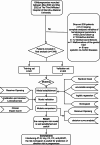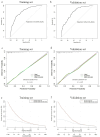A nomogram based on hematological parameters for prediction of spontaneous abortion risk in pregnancies
- PMID: 40069650
- PMCID: PMC11899064
- DOI: 10.1186/s12884-025-07396-4
A nomogram based on hematological parameters for prediction of spontaneous abortion risk in pregnancies
Abstract
Background: Pregnancy loss significantly affects physical and mental health. A nomogram for predicting spontaneous abortion risk was developed to improve pregnancy outcomes.
Methods: A total of 1346 pregnant women were enrolled from The Third Affiliated Hospital of Wenzhou Medical University (May 2020 - May 2022). The training set included 941 participants, and the validation set had 405. Feature selection was optimized using a random forest model, and a predictive model was constructed via multivariable logistic regression. The nomogram's performance was assessed with receiver operator characteristic (ROC), Hosmer-Lemeshow test, calibration curve, and clinical impact curve (CIC). Discrimination and clinical utility were compared between the nomogram and its individual variables.
Results: Antithrombin III (AT-III), homocysteine (Hcy), complement component 3 (C3), protein C (PC), and anti-β2 glycoprotein I antibody (anti-β2GP1) were identified as risk factors. The nomogram demonstrated satisfactory discrimination (Training AUC: 0.813, 95% CI: 0.790-0.842; Validation AUC: 0.792, 95% CI: 0.741-0.838). The Hosmer-Lemeshow test (P = 0.331) indicated a good fit, and the CIC showed clinical net benefit. The nomogram outperformed individual variables in discrimination (AUC: 0.804, 95% CI: 0.779-0.829).
Conclusion: The developed nomogram, incorporating AT-III, Hcy, C3, PC, and anti-β2GP1, aids clinicians in identifying pregnant women at high risk for spontaneous abortion.
Keywords: Abortion; Hematological parameters; Nomogram; Receiver operator characteristic.
© 2025. The Author(s).
Conflict of interest statement
Declarations. Ethics approval and consent to participate: This study was reviewed and approved by the Ethics Committee of The Third Affiliated Hospital of Wenzhou Medical University. The patients/participants provided written informed consent to participate in this study. Consent for publication: Before participating in the study, all participants signed up with informed permission. Competing interests: The authors declare no competing interests.
Figures





Similar articles
-
Constructing a logistic regression-based prediction model for subsequent early pregnancy loss in women with pregnancy loss.Eur J Med Res. 2025 Feb 12;30(1):99. doi: 10.1186/s40001-025-02361-5. Eur J Med Res. 2025. PMID: 39940054 Free PMC article.
-
A predictive model of pregnancy loss using pre-pregnancy endocrine and immunological parameters in women with abnormal glucose/lipid metabolism and previous pregnancy loss.Endocrine. 2024 Oct;86(1):441-450. doi: 10.1007/s12020-024-03937-7. Epub 2024 Jun 19. Endocrine. 2024. PMID: 38898223 Free PMC article.
-
Development and validation of a nomogram to predict depression in older adults with heart disease: a national survey in China.Front Public Health. 2024 Dec 11;12:1469980. doi: 10.3389/fpubh.2024.1469980. eCollection 2024. Front Public Health. 2024. PMID: 39722705 Free PMC article.
-
[Establishment of a nomogram prediction model for 28-day mortality of septic shock patients based on routine laboratory data mining].Zhonghua Wei Zhong Bing Ji Jiu Yi Xue. 2024 Nov;36(11):1127-1132. doi: 10.3760/cma.j.cn121430-20240202-00108. Zhonghua Wei Zhong Bing Ji Jiu Yi Xue. 2024. PMID: 39697015 Chinese.
-
A nomogram to predict the risk of insulin resistance in Chinese women with polycystic ovary syndrome.Front Endocrinol (Lausanne). 2024 Nov 27;15:1446827. doi: 10.3389/fendo.2024.1446827. eCollection 2024. Front Endocrinol (Lausanne). 2024. PMID: 39665024 Free PMC article.
References
-
- Quenby S, Gallos ID, Dhillon-Smith RK, Podesek M, Stephenson MD, Fisher J, Brosens JJ, Brewin J, Ramhorst R, Lucas ES. Miscarriage matters: the epidemiological, physical, psychological, and economic costs of early pregnancy loss. Lancet. 2021;397(10285):1658–67. - PubMed
-
- No RG-tG. The investigation and treatment of couples with recurrent first-trimester and second-trimester miscarriage. RCOG: London, UK; 2011.
-
- Farren J, Jalmbrant M, Falconieri N, Mitchell-Jones N, Bobdiwala S, Al-Memar M, Tapp S, Van Calster B, Wynants L, Timmerman D, et al. Posttraumatic stress, anxiety and depression following miscarriage and ectopic pregnancy: a multicenter, prospective, cohort study. Am J Obstet Gynecol. 2020;222(4):367. e361-367 e322. - PubMed
-
- Li C, Xiao L, Tang L, Zeng D, Huang S. Application of QF-PCR technology combined with early pregnancy ultrasound in prenatal screening for fetal chromosomal aneuploidy. Altern Ther Health Med. 2023;29(7):198–203. - PubMed
MeSH terms
Substances
Grants and funding
LinkOut - more resources
Full Text Sources
Medical
Miscellaneous

